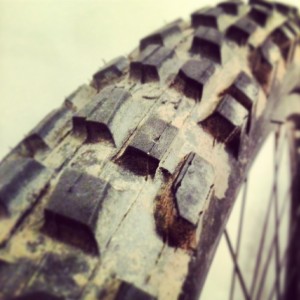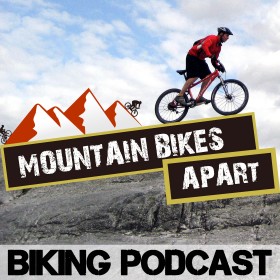- 6. Popular Mountain Bike Brands
- 7. The Best Mountain Bikes, by Category
- 8. Where to Buy a Mountain Bike
- 9. Used Mountain Bikes: Buying Second Hand
- 10. Mountain Bike Sizing
Chapter 4: Mountain Bike Wheel Sizes
Knowing Your 29ers From Your 69ers, and Much More
 For a long time, for most riders, the size of your wheels just simply wasn’t worth worrying about. It was all about 26 inchers, and you didn’t question it. That was the spec for us, out of all of the mountain bike wheel sizes on offer – end of story.
For a long time, for most riders, the size of your wheels just simply wasn’t worth worrying about. It was all about 26 inchers, and you didn’t question it. That was the spec for us, out of all of the mountain bike wheel sizes on offer – end of story.
Recently things have been a-changing, however. Despite the fact that the more specialist mountain bike wheel sizes have actually been around since the beginning, only now are they entering the spotlight.
With that increase in popularity, mountain bike companies are starting to really explore the more innovative wheel sizes. Unlike the older days, mountain bikers can now choose from 26”, 29” (29er), 650b (27.5”) and 69er specs. With so many mountain bike wheel sizes to choose from, new riders might well find the options overwhelming.
The things is, though, there isn’t one right size for everyone. Choosing the mountain bike wheel size that’s right for you is totally dependent on your personal tastes, riding style and where/how you plan to use your bike. So, let’s look at the options – time for a good ol’ pros and cons!
The 26” – Grand-Daddy of Mountain Bike Wheel Sizes
For decades, the 26” wheel was the industry standard for mountain bikes. Originally, 26” wheels were used because, basically, it was the only one available! Consequently, the early pioneers of mountain bike riding made 26” wheels work because they didn’t have any other option.
The foremost advantage of 26″ wheels is that they are the smallest of the bunch (exluding BMX style wheels, but we’re not in it for the stunts…). And, as we all know, smaller generally equals lighter. For a mountain biker, cutting excess weight while maintaining your ability to control the bike is a big deal. There are a few reasons for this, let’s have a look.
First, 26” wheels are outstanding on exceptionally steep or stepped climbs in rough terrain thanks to the ease of acceleration they offer. Often, riders have to stop suddenly to overcome an obstacle and then find themselves trying to rapidly accelerate. The 26” wheel, thanks to it’s light weight, allows the rider to accelerate quickly out of these situations, helping to maintain their forward momentum.
Next, light wheels mean the bike in general is exceptionally light. This keeps it nice and responsive, allowing the rider to hop over or around obstacles. It also helps with cornering, creating a really active ride and a great sense of control. On a 26″ you feel on top of things, able to deal with anything in your path quickly and effectively.
To the cons though – despite these great characteristics, descending a steep embankment on a 26” wheel is not for the faint of heart. An extra inch to three inches of tire size may not seem to make a difference; however, when trying to maintain control of a light and fast moving bicycle the additional tire circumference can be the difference between a fall and a successful ride. Furthermore, the 26er’s riding position has a higher center of gravity that makes it difficult to maintain stability.
The 27.5”/650b Wheel Size
Considered by many industry experts to be a great compromise between the 26” and 29” mountain bike wheel sizes, the 650b provides you with big wheels to navigate difficult terrain, but doesn’t go so big that acceleration becomes a hindrance.
Why are Bigger Mountain Bike Wheels Sizes Better on Rough Terrain?
The difficult terrain thing is probably worth a quick explanation before we go on, as it’s one of the big advantages going to the big wheels. Imagine cycling along, and hitting a 6 inch step-up. A tiny wheel, only 12 inches tall, would hit the step square on – flat front of the wheel contacting with the top of the step. This, as you’d imagine, makes for a pretty tricky traverse. Double the size of the wheel, though, and suddenly the wheel is contacting the step at an angle. This makes things a lot easier. The bigger the wheel > the shallower the angle of attack > the easier obstacles are to get over.
So, bigger wheels mean a smoother ride on rougher terrain.
So, getting back to the 650b in particular, the slightly larger wheel offers a more comfortable ride than a 26″ and it also offers more stiffness and durability than a 29er (the bigger your wheels, the more they bend). Plus, if you’re on the small side, the 650b could be a perfect fit, as the 29er can feel pretty big to average and under riders.
The 650b also comes with a more natural riding position than the 26er and leaves the rider a bit more comfortable. But, of course, the slightly larger wheels mean a bit more weight and angular momentum. This means the steering will not be as crisp or as tight as the 26er.
The 29er Wheel Size
Now we’re up to the biggest wheels – Mr ‘exploding in popularity’ 29er. These wheels are everywhere these days, and you wont find many manufacturers that don’t have at least one 29er model on their books.
As we discussed earlier, these wheels are the easiest to get over any obstacle thanks to their extensive diameter. Another advantage of bigger wheels is a large contact patch with the ground, providing you with better grip and braking.
One slightly counter-intuitive advantage is that 29er mountain bikes actually have a lower effective centre of gravity, making you feel stable and low to the ground. This is because the bottom bracket is the same height off the ground as a 26inch bike, but the axles are higher. All sorts of complicated physics whizz around and produce the fact that you just feel more ‘planted’ on a 29er, and they really suit taller riders who can sometimes feel perched on top of the smaller 26 inch wheels.
The large wheels are pretty good for descending steep hills. The additional diameter of the wheels can give the rider a bit more confidence in getting through particularly technical terrain. This is because the tires are bigger and harder to deflect, giving a bit of additional stability and control.
Another big advantage of the big wheels is that once momentum has been generated, the 29er is able to maintain its speed and acceleration really well. This is partly due to the ease of getting over obstacles mentioned earlier, and partly due to the additional weight, generating a whole lot of extra angular momentum. That stuff’s hard to stop.
On the downside, shorter riders may not feel very comfortable on a 29er. Also, the flip-side of being able to maintain speed easily, getting up to that speed in the first place is a lot harder work. Acceleration is not a strength of the big wheels…
The 69er Wheel Size
Billed as a combo mountain bike, the 69er or combo wheel size is a relatively old idea that has not gained much momentum in the biking industry. Essentially, a 69er has a larger wheel in the front for obstacles and a smaller wheel in the rear for quick acceleration. It’s a good idea in principle, bit just doesn’t pan out very well in practicality. Most of the folk you find riding a 69er do so out of that sense of individuality you often find in bikers – that desire to stand out and be a bit different. Nothing wrong with that of course, but it does take a bit of work to put together a 69er, so you’ve got to want that individuality bad.
There aren’t many bike manufacturers that produce a 69er standalone model because of those practical bike-building problems, but the idea is becoming more popular as the ‘stand-alones’ mentioned above rave about the advantages. I wonder if in the coming years we can expect to see more combo bikes. They just seem really good at accommodating riders who are too small to ride the 29er, but want the additional off road capabilities of a larger wheel.
Read More of the 'What Mountain Bike Guide'
- 6. Popular Mountain Bike Brands
- 7. The Best Mountain Bikes, by Category
- 8. Where to Buy a Mountain Bike
- 9. Used Mountain Bikes: Buying Second Hand
- 10. Mountain Bike Sizing


Recent Comments